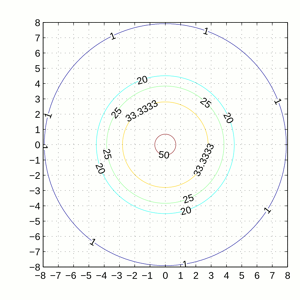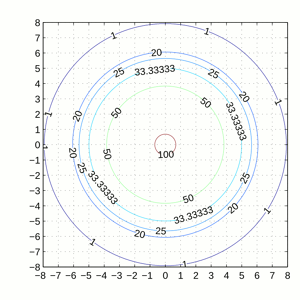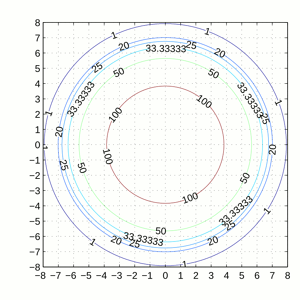
A TNT explosion.
An explosion is a physical event, generally destructive, that can be caused by several different circumstances. It can destroy nearby blocks, propel and damage nearby players, entities, and their armor, and cause one or more fires under correct circumstances. Explosions produce a "shockwave" particle effect.
Multiple close explosions may propel objects further, but have no cumulative effect on the destruction of a block - for example, no amount of TNT will destroy a block of Obsidian, even if it all explodes at once. This is because explosion damage to blocks is evaluated individually (per explosion), and blocks' blast resistance do not become "weakened" from previous explosions.
The propulsion effect of explosions is often used for TNT cannons, and can also be used to shoot out gravity affected blocks.
Explosion strength[]
| Explosion Type | Power | Creates fire? | Notes |
|---|---|---|---|
| Wither [Bedrock Edition only] (half health charge move) | 8 | No | Breaks any block that is breakable in survival mode (except reinforced deepslate), ignoring blast resistance. Does no terrain damage when the mobGriefing game rule is set to false.
|
| Wither (when spawned, or when killed[Bedrock Edition only]) | 7 | No | Does no terrain damage when the mobGriefing game rule is set to false.
|
| End crystal (when destroyed) | 6 | No | |
| Charged creeper | 6 | No | Drops heads or skulls of mobs killed by explosion. Does no terrain damage when the mobGriefing game rule is set to false.
|
| Beds when used in the Nether, the End or custom dimensions | 5 | Yes | Uses the death message "(player) was killed by [Intentional Game Design]"[Java Edition only] |
| Respawn Anchor when used in the Overworld, the End or custom dimensions | 5 | Yes | Uses the death message "(player) was killed by [Intentional Game Design]"[Java Edition only] |
| TNT | 4 | No | Any blocks destroyed by explosion drop their respective items. No effect when in water. |
| Underwater TNT[Bedrock Edition and Minecraft Education only] | 4 | No | Damages terrain, even when underwater. |
| Creeper | 3 | No | Does no terrain damage when the mobGriefing game rule is set to false.
|
| Fireball (ghast projectile) | 1 | Yes | Does no terrain damage when the mobGriefing game rule is set to false. Does not damage Cobblestone.
|
| Black wither skull | 1 | No | Does no terrain damage when the mobGriefing game rule is set to false.
|
| Dangerous wither skull | 1 | No | Treats blocks breakable in survival mode as having a blast resistance of no more than 0.8. Does no terrain damage when the mobGriefing game rule is set to false.
|
Despite doing damage to entities, fireworks do not destroy terrain and as such are not counted as conventional explosions.
Lab tables sometimes perform a non-terrain-damaging explosion when creating garbage item.[Bedrock Edition and Minecraft Education only]

Comparison of explosion craters, from a charged creeper (left), TNT (center) and regular creeper (right).
Effect[]
Model of block destruction[]

The rays from the explosion center to points that are uniformly distributed on the surface of a cube centered at the explosion with an edge length of 2. (However, this defines only their directions, not their length).
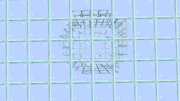
The roughly spherical pattern of blocks destroyed can be seen here.
An explosion can destroy nearby blocks. Its blast effect is evaluated independently on many explosion rays originating from the explosion center, as shown in the right figure.
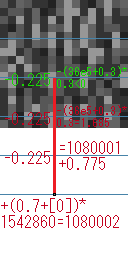
An explosion must be powerful (power ~1542860[verify]) to destroy a bedrock block.
- A cube around the explosion is divided into a 16×16×16 grid, and rays are created from the center to each outer point of this grid, meaning that there are a total of 1352 rays.
- Each ray is given an intensity, calculated as (0.7 + [a random value from 0 to 0.6]) × [power].
- For every attenuation step (0.3 blocks along the ray), the intensity of the ray is reduced by 0.225 (0.3×0.75). If the block passed through is anything other than air, it is further reduced by (blast resistance + 0.3) × 0.3.
- The ray destroys any blocks that could not reduce the ray intensity to zero at any checkpoint.
From the above process, the following results can be deduced (where is the floor function):
- The maximum blast radius (assuming no block absorption) is = 10.4 (charged creepers), 6.9 (TNT), 5.2 (creepers), 1.7 (fireballs). For example, a TNT explosion can destroy a torch 7 blocks away. However, how many blocks an explosion can destroy is non-deterministic and also dependent on the specific location of the explosion.
- The minimum block resistance required to absorb maximum blast force of an explosion happening in nearby air = . To not be destroyed, a block has to absorb all blast force at the first checkpoint in it.
- The attenuation steps is subject to collision restrictions. For explosion in air, there is at least one attenuation step. TNT and creeper explosions are always 0.49 and 0.5 blocks away from nearest block (2 attenuation steps), but fireball explosions can happen anywhere (1 attenuation step).
- Thus, the block resistances are 24.2 (charged creepers), 15.534 (TNT), 11.2 (creepers), 3.284 (fireballs).
- So water, lava (the stationary block), obsidian, and bedrock are always indestructible, and fences and less blast-resistant blocks can be destroyed by fireballs. These are theoretical values, and in reality less resistant blocks are not always destroyed; there is no such mechanic.
Dropping blocks[]
Destroyed blocks have a 1⁄p chance of dropping as collectible resources, where p is the explosion power. So, blocks destroyed by an (uncharged) creeper's explosion have a 1⁄3 chance of dropping. However, dragon eggs, beacons, conduits, heads, shulker boxes and decorated pots always drop from explosions, though the items may be destroyed by subsequent explosions. In addition, in Java Edition, explosions from TNT and minecarts with TNT cause a 100% drop rate; this is not the case in Bedrock Edition.[1]
In Java Edition, the drop chance of blocks in explosions can be customized via three game rules:
blockExplosionDropDecaycontrols whether block-based explosions (e.g. a bed explosion) cause only some blocks to drop.- It is set to
trueby default. - An end crystal explosion is controlled by this game rule, despite the end crystal being an entity.
- It is set to
mobExplosionDropDecaycontrols whether mob-based explosions (e.g. a creeper explosion) cause only some blocks to drop.- It is set to
trueby default.
- It is set to
tntExplosionDropDecaycontrols whether TNT explosions cause only some blocks to drop.- It is set to
falseby default.
- It is set to
The precious blocks listed above always drop from explosions, regardless of the values of these game rules.
Interaction with entities[]
An explosion has different effects on entities than blocks. Entities are damaged and propelled by an explosion if within its damage radius of 2 × power. Note that the "damage radius" is different from the blast radius of explosion effect on blocks.
- For every entity within a 2×[power] block sphere of the explosion center, the impact is (1-[distance from explosion/damage radius])×[exposure] (see section below on exposure).
- The entity is damaged by ((impact×impact+impact)×7×power+1) rounded down (armor enchantments for damage are handled separately). This is scaled by difficulty.
- After damage, exposure is reduced by (exposure×[max Blast Protection from all armor]×0.15).
- The entity's eyes are propelled along the ray from the explosion center by the new exposure.
From the above process, the following results can be deduced:
- Entities always get at least 1 point of damage if they are within the radius, regardless of their explosion exposure.
- The maximum damage that entities can take (at the explosion center with 100% exposure and normal difficulty) = (1 × 1 + 1) × 7 × power + 1 point of damage = 99, (Wither newly spawned by the player), 85 (charged creepers), 71 (Beds when using in the Nether or in the End), 57 (TNT), 43 (creepers), 15 (fireballs). When entities are away or covered by blocks from the explosion center, they take less damage.
- The maximum velocity gain that an entity can obtain from a single explosion is 1, at the explosion center with 100% exposure.
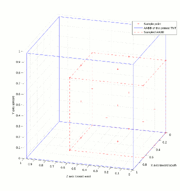
A primed TNT AABB has directionally asymmetrical sample points (1/2.96 spacing) because of rounding.
Calculation of explosion exposure[]
- The entity's bounding box is divided into a [2×width+1] by [2×height+1] by [2×depth+1] grid of unequally spaced points.
- A ray is drawn from the explosion center to each point.
- The exposure of the entity is the percentage of these rays that are unobstructed by solid blocks.
The approximation algorithm has sampling error that results in directional asymmetry of propulsion. For example, a typical TNT cannon has maximum range in the west direction partly because the primed TNT has largest sampled exposure in that direction.[verify]
Causing fire[]
If the explosion has the ability, it randomly starts fires in ⅓ of all destroyed air blocks that are above opaque blocks.
Prolonged lag[]
In addition to the initial lag from processing the explosion, which subsides once the explosion has occurred, there can also be a prolonged fallout from an explosion, that consists of dropped items, liquid physics, and increased render-complexity of the crater. Technically, the dropped items disappear after 5 minutes, however those 5 in-game minutes may take a long time to process during extreme lag.
Certain rules and commands can be used to avoid this prolonged lag: setting the game rule doTileDrops to false, for instance with /gamerule doTileDrops false, prevent dropped items from being generated by explosions. Also, the command /kill @e[type=item] destroys all dropped items.
Blast resistance[]
The following table shows blast resistance values for blocks as shown in Minecraft's code. In Add-ons for Bedrock Edition, these values are multiplied by 5 when used for the "explosion_resistance" value in the "minecraft:descructible_by_explosion" component.
Typical damage radius[]
The player receives damage, if within these radii of a 100% exposure ground 1 block, 2 blocks, or 4 blocks of TNT explosion, with the amount of damage labeled on each circle in the figures below.
Sounds[]
| Sound | Subtitles | Source | Description | Resource location | Translation key | Volume | Pitch | Attenuation distance |
|---|---|---|---|---|---|---|---|---|
| Explosion | Blocks | When something explodes | entity | subtitles | 4.0 | 0.56-0.84 | 16 |
| Sound | Source | Description | Resource location | Volume | Pitch |
|---|---|---|---|---|---|
| Blocks | When something explodes | random | 4.0 | 1.0 |
History[]
| May 21, 2009 | Notch shows interest in adding an explosive block. | ||||
|---|---|---|---|---|---|
| Java Edition Classic | |||||
| 0.24_SURVIVAL_TEST | Added creepers. | ||||
| October 24, 2009 | Showed off TNT. | ||||
| 0.26 SURVIVAL TEST | Added TNT. | ||||
| Java Edition Indev | |||||
| 0.31 | 20100122 | Explosions are now "better". | |||
| 20100125-1 | Explosions now lose power when going through stronger materials. | ||||
| Java Edition Alpha | |||||
| v1.2.0 | preview | Added ghasts, which shoot explosive fireballs. | |||
| Java Edition Beta | |||||
| 1.5 | Creepers now become charged when struck by lightning, increasing the explosion's radius and strength. | ||||
| 1.6 | Test Build 3 | When the player tries to sleep in the Nether, they now cause the bed to explode. | |||
| 1.8 | Pre-release | Explosions now emit shockwave particles. Prior to Beta 1.8, explosions emitted only smoke. | |||
| Sound Update | The 'Sound Update' on November 11th, 2011 gave TNT a new explosion sound. | ||||
| Java Edition | |||||
| 1.0.0 | Beta 1.9 Prerelease 3 | Bed and fireball explosions now cause fires. | |||
| Beta 1.9 Prerelease 4 | When the player tries to sleep in the End, they now cause the bed to explode. | ||||
| Enchantment Blast Protection added, which can enhance an armor's resistance against explosions. | |||||
| Beta 1.9 Prerelease 6 | End crystals added, which can be destroyed with a melee or hit with an arrow or snowball, causing an explosion. | ||||
| 1.3.1 | 12w24a | Fixed the issue of explosions not propelling players. | |||
| 12w30a | Explosions now damage the player different amounts on different difficulties. However, no damage is dealt to the player on Peaceful. | ||||
| 1.4.2 | 12w34a | Added the wither, which shoots black wither skulls. | |||
| 12w37a | An emergent wither now make a massive explosion when its health is fully charged. | ||||
| Blue wither skulls added. | |||||
| 12w38b | New creeper fall mechanics have been added. Creepers now explode if they fall on the player from a certain height. | ||||
| 1.5 | ? | Destroyed blocks now have a 1/power chance of dropping as items; previously it was a fixed 30% chance. | |||
| ? | The Nether's biome now controls whether beds explode. As such, superflat worlds with this biome set will have beds explode in the Overworld. It is not known if Overworld biomes in the Nether allow sleeping as a result of this.[more information needed] | ||||
| 1.8.2 | pre1 | Explosions are now no longer directionally biased. | |||
| 1.14 | 19w11a | Destroyed blocks from TNT or minecart with TNT explosions now have a 100% chance of dropping as items. | |||
| 1.15 | pre1 | Explosions no longer create smoke particles.[2] | |||
| 1.16 | 20w12a | Added respawn anchors, which explode in a similar fashion to a bed, if charged and used in the Overworld and the End dimensions. | |||
| 20w18a | The Nether Wastes biome no longer allows for beds to explode in the Overworld.[3][more information needed] | ||||
| 1.16.2 | ? | Custom dimensions can specify whether beds and/or respawn anchors explode when used, | |||
| 1.19.3 | 22w44a | Added the following game rules:
| |||
| Pocket Edition Alpha | |||||
| v0.1.0 | Added TNT. | ||||
| v0.2.1 | TNT now actually explodes. | ||||
| v0.4.0 | Added creepers. | ||||
| v0.12.1 | ? | Creepers now become charged when struck by lightning, increasing the explosion's radius and strength. | |||
| Added ghasts, which shoot explosive fireballs. | |||||
| Enchantment Blast Protection added, which can enhance an armor's resistance against explosions. | |||||
| When the player tries to sleep in the Nether, they cause beds to explode. | |||||
| ? | Added explosion particles. | ||||
| TNT now uses a new explosion sound. | |||||
| v0.14.0 | ? | An invalid mixture of liquids in cauldrons now result in a non-damaging explosion effect. | |||
| v0.16.0 | build 4 | Withers added. | |||
| Pocket Edition | |||||
| 1.0.0 | alpha 0.17.0.1 | End crystals added. | |||
| When the player tries to sleep in the End, they now cause the bed to explode. | |||||
| 1.0.7 | Explosions no longer deal damage to a player, if the explosion is in water. | ||||
| Bedrock Edition | |||||
| 1.4.0 | beta 1.2.20.1 | Creating garbage in Lab Table sometimes cause explosion sound. | |||
| Added Underwater TNT, which can damage terrain underwater. | |||||
| ? | Removed the non-damaging explosion effect from cauldrons, replaced with a hiss and smoke. | ||||
Trivia[]
- Explosions with a power greater than 100 look mostly the same from the outside, as only certain lines are used to determine if a block breaks. However, some of those lines continue underground.
- Explosions that occur in flowing water or lava apply propulsion to entities, but don't affect any blocks, regardless of the blocks' blast resistance.
- Underwater explosions don't emit smoke particles.
- Explosions can redirect projectiles, including ender pearls.
- An explosion just after a mob's death can propel the mob's body.
- If primed TNT explodes in a large, solid cube of stone blocks, it creates an exact 3×3×3 cube inside. Experimentation confirms that a TNT detonation causes a 3×3 hole in a solid block of anything with a blast resistance less than that of water, but more than 2.5 (e.g. crafting tables). This implies that 3×3 is the minimum possible result of a TNT detonation without the blast being resisted altogether.
- If a falling sand entity falls into primed TNT when in water, it deals block damage.
- Every block that has a higher blast resistance than cobwebs can block a ghast's fireball and remain intact.




